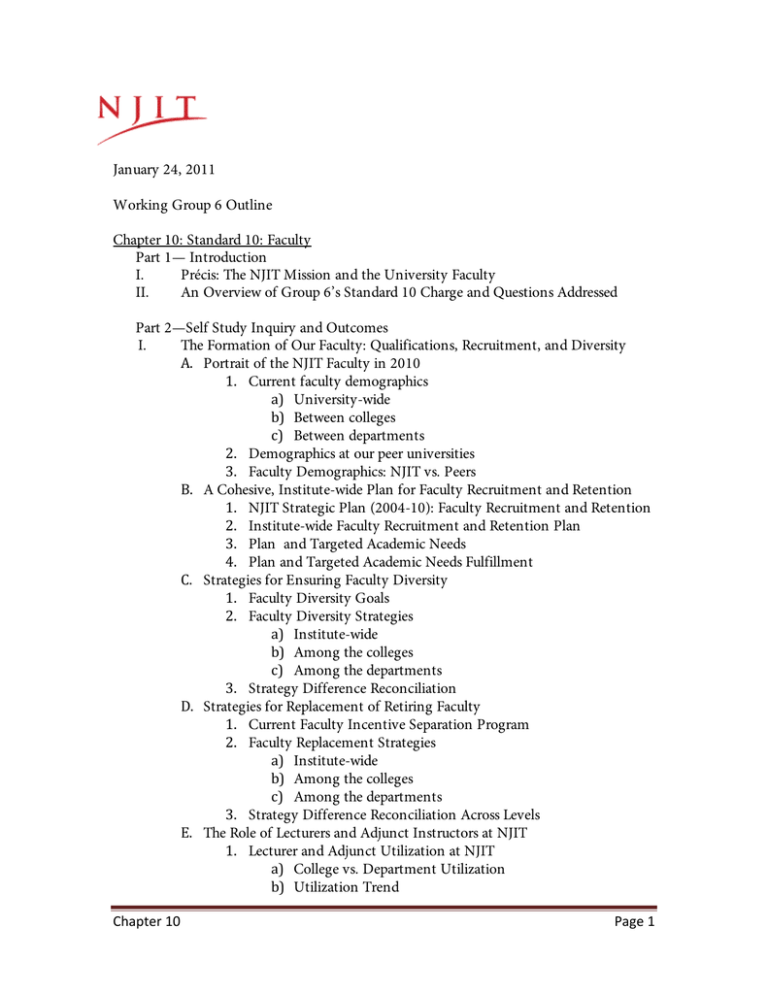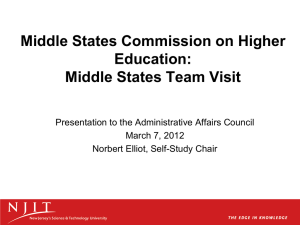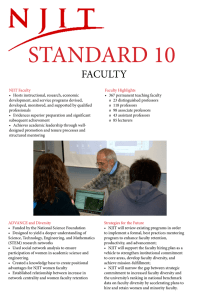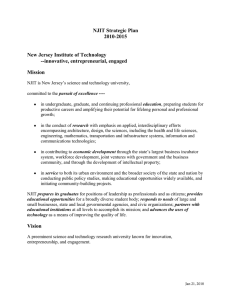Document 13171441
advertisement

January 24, 2011 Working Group 6 Outline Chapter 10: Standard 10: Faculty Part 1— Introduction I. Précis: The NJIT Mission and the University Faculty II. An Overview of Group 6’s Standard 10 Charge and Questions Addressed Part 2—Self Study Inquiry and Outcomes I. The Formation of Our Faculty: Qualifications, Recruitment, and Diversity A. Portrait of the NJIT Faculty in 2010 1. Current faculty demographics a) University-wide b) Between colleges c) Between departments 2. Demographics at our peer universities 3. Faculty Demographics: NJIT vs. Peers B. A Cohesive, Institute-wide Plan for Faculty Recruitment and Retention 1. NJIT Strategic Plan (2004-10): Faculty Recruitment and Retention 2. Institute-wide Faculty Recruitment and Retention Plan 3. Plan and Targeted Academic Needs 4. Plan and Targeted Academic Needs Fulfillment C. Strategies for Ensuring Faculty Diversity 1. Faculty Diversity Goals 2. Faculty Diversity Strategies a) Institute-wide b) Among the colleges c) Among the departments 3. Strategy Difference Reconciliation D. Strategies for Replacement of Retiring Faculty 1. Current Faculty Incentive Separation Program 2. Faculty Replacement Strategies a) Institute-wide b) Among the colleges c) Among the departments 3. Strategy Difference Reconciliation Across Levels E. The Role of Lecturers and Adjunct Instructors at NJIT 1. Lecturer and Adjunct Utilization at NJIT a) College vs. Department Utilization b) Utilization Trend Chapter 10 Page 1 II. III. 2. Outside Classroom Tasks 3. Lecturer and Adjunct Resources 4. Lecturer and Adjunct Compensation: NJIT vs. Peers The Health of Our Faculty: Resources, Support, Retention, and Growth A. Faculty Mentoring Processes 1. New-faculty Mentoring Plans a) Institute-level b) College-level c) Department-level 2. Plan Improvement and Dissemination 3. New-faculty Mentoring Plans: NJIT vs. Peers 4. Established and Mid-Career Faculty Mentoring Plans a) Comparison of NJIT vs. Peer Plans (or Need for Development of Plan) B. Resource Allocation to Faculty 1. New Faculty: Internal Research Startup Funds a) Institutional-level b) College-level c) Department-level 2. Established and Mid-Career Faculty: New Research and Initiative Funds a) Fund Allocation Process 3. Resource Allocation Equity a) Inequity Recognition b) Inequity Remedies 4. Maintaining, Enhancing, and Recognizing Faculty Productivity a) Internal Resources and Maintenance of Faculty Productivity b) Assessment of Current Efforts and Resources c) Measurement of Faculty Productivity d) New Performance-based Salary Increase System e) Department Promotion and Tenure Inequities The Role of Our Faculty in the Life of NJIT: Curriculum, Service, and Governance A. The Faculty and Education 1. Teaching Load Assignment a) Current Process b) Evaluation of Process: Effectiveness and Equity 2. Faculty Involvement in Academic Program Development a) University-wide level b) College-wide level c) Department-wide level 3. Evaluation of Faculty Involvement B. The Faculty, Learning Technologies, and Education Assessment 1. Instruction Assessment Chapter 10 Page 2 2. Merit Instruction Performance Incentives 3. New Technology and Improvement of Instruction Quality 4. Assessment of Impact of New Technology 5. Incentives for Faculty New Technology Utilization C. The Faculty and Research 1. Role of Faculty Research Interests in NJIT Research Plans a) On the institute level b) On the college level c) On the department level 2. Role of Faculty Research Interests in Curriculum a) Mechanism and Level of Role b) Incentives for Incorporation D. The Role of Faculty Governance 1. Forms of Faculty Governance a) Faculty Council b) Department P&T committees 2. Faculty Governance: NJIT vs. Peers a) Structural b) Perceived effectiveness E. The Faculty and Service 1. Forms of Faculty Service a) At institute level b) At college level c) At department level 2. Service Recognition and Reward System a) New faculty annual summary b) New merit-based faculty salary system Part 3—Critical Analysis and Conclusions Part 4—Collaboration with other Working Groups Part 5—Recommendations for Improvement Chapter 10 Page 3





